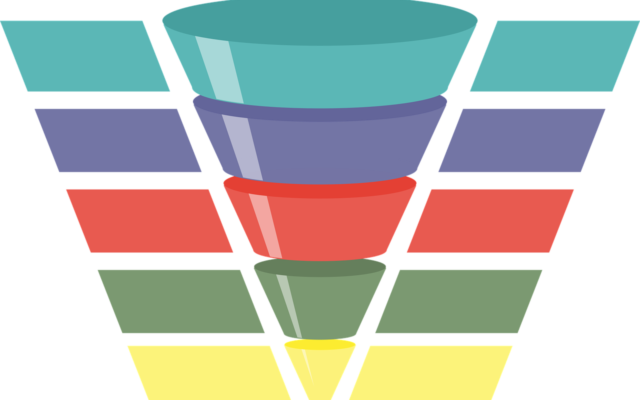Transformation has many facets, but just one primary objective – to create a more efficient organisation. That means being more efficient in responding to the needs of the digital consumer and all that entails.
It embraces things such as the process of analysing end-user needs, developing new products and services and creating the structures and practices that will produce and distribute the solution to the most people with the minimum effort.
A lot of this concerns internal processes and, once you have defined your brand your digital transformation, the next logical area of focus has to be your customer journey and sales funnel.
I’m still amazed that so many of the businesses I come across haven’t defined their brand, so I guess I shouldn’t be phased by those yet to map their customer journey or even build their Customer Relationship Management process.
However, it’s a comparatively logical process and a relatively quick-win for most businesses that are still limping along with an undefined or partly developed customer journey. There’s absolutely no reason not to have done this.
The first steps of your customer journey and your digital sales funnel
The best way I have found to start mapping your customer journey is to gather a team of people from the marketing and sales teams and a long piece of paper (and I mean L-O-N-G! – I usually join several pieces of A2 paper end-to-end along a wall or boardroom table) or, if you have one, a white wall (a normal white-board won’t usually be wide enough).
Start by listing the things you do to start the sales process. You can offer freebies like white papers, brochures, tricks of the trade, anything that has value to your prospects and is compatible with your fundamental proposition or product.
If your strategy says you should be seeking to build your authority, use white papers and articles to demonstrate what you know and help prospects gain a better understanding of the issues they face when dealing with your sector.
These first initiatives have come to be known as “lead magnets” and that’s what they do – attract people who have a propensity to buy what you are offering.
The role of content in your customer journey
You may like to produce content in the form of articles or videos that deal with issues associated with your sector, product or offer. If you write articles with an eye to their search engine value you may get traffic just by posting them.
A plug-in like Yoast will help you with the basics of this, but most subject areas are highly competitive so, at best, you can expect it to take a while to build an audience. You will still have to post alerts to your content on social media though.
Consider the range of different responses a prospect may have to each of these initial engagements. They could ignore them, read them and that’s all, click to a landing page, or engage there for example. List these and identify your own follow-up responses.
Do this repeatedly, creating a decision-tree type diagram that fans out and re-converges as your prospect makes decisions and progresses through the journey. When prospects don’t respond, you can re-issue initial e-mails or follow up with messaging or mails that encourage them to re-engage.
You can offer incentives, refer them to your customer service team, offer a consultation, time-sensitive discounts or just kind words. Remember, initial communications like social media posts have a longer life that you may think. You can re-post these many times and reach different people each time.
In all scenarios other than where your journey kicks off with an e-mail, you won’t know who your prospects are, so your initial objective is to get them to announce themselves by providing their name and contact details. The hope is they’ll do this in exchange for what you are giving away, so whatever that is, it will have to have value to them.
The difference between being helpful and being a pest.
If you map your responses in this way you’ll eventually find that you’ll run out of options with some prospects – with an e-mail campaign this occurs when you are in danger of making them feel you are stalking them. If you are using a mailing list, a good indicator is the number of “unsubscribes” you get.
You’ll always get some, especially at first, but there’s a level where unsubscribes are not good and you’ll have to work that out for yourself. That’s a judgement call you’ll have to make, but by then you’ll have gathered contact details on a sizeable proportion of your initial contacts.
It’s a numbers game in some respects, although you will refine it by considerate targeting. Always write stuff, offering incentives and couch your proposition with your customer in mind.
Leverage the technology.
One of the many benefits technology offers us is the ability to track customers and prospects and, maybe more importantly, to ensure the contacts you have on your database aren’t duplicated. Duplications are a bad thing. They are annoying for prospects and customers because it could mean they receive too many and sometimes conflicting communications from you.
Also, in the era of omni-channel marketing customers don’t expect to have to provide information to you more than once. I once worked with one of the world’s biggest satellite TV companies who had evolved a disconnected database – more than one in fact – which meant prospects were getting mail-boxes full of different offers from them, sometimes more than three times in a week.
This was causing recipients to bin them without reading them. We increased engagement by integrating all their data, building a new database and streamlining the targeting of messages.
Duplications commonly occur when encounters with the same prospect aren’t linked. To do this you need a reference point. Something that you can use to identify the person by. In the Middle East it tends to be mobile phone numbers. They are used by every organisation from national governments down as the identifier.
That could work in most countries because these days people keep their numbers irrespective of the provider they use. It’s also quite a good option because of the shift toward mobile devices, so your primary contact point will be their preferred device.
An omni-channel customer journey
If you are operating an on-line sales operation you need to be able to reference previous engagements with that customer in subsequent conversations. If your operation is multi-channel they should be able to take up where they left of last time they were in touch, regardless of where that may have been.
I was talking to a retailer recently about the idea of using electronic contact points (mounted tablets) around their stores where customers could log in and take up a conversation where they may have left off on-line. This can also be done on customers’ own handsets. I’ve worked with beacons too to produce an even neater connection that reduces the log-on barrier.
Technology also comes to the rescue in building and managing your customer journey. Most CRM platforms incorporate intuitive drag-and-drop tools for constructing your sales funnel. The more sophisticated and responsive you want to be (and believe me, once you get used to this you’ll want to do increasingly more) the more heavyweight your tech needs to be.
You don’t want to find yourself needing to change platforms a few months into your plan, so it pays to ensure you have room to grow into the platform you choose to start your process.
There are APIs to connect additional platforms – e-mail builders, landing page templates, analytics and mailing platforms – to any of the worthwhile CRM platforms, but the good ones have enough features to accommodate your needs for a while.
Keeping your objective in view.
Having collected their contact details your next objective will be to secure a sale. If this is an on-line transaction you may never have had a direct conversation with your customer, but there may be occasions when you want to entice them into your office, showroom or physical store, which is where the point about having just one file on each customer’s particular relevance.
Don’t think for a moment though, that this is the end of your customer journey. In fact, it’s just the start. The real value of customers lies in subsequent sales, which is why the retention/acquisition balance of switched-on businesses has, for some years, leant toward customer retention.
To be effective at this you need to build a relationship with every customer, which means becoming ever more personalised in the conversations you have with them. This is why collecting data from every encounter is essential.
Gaining the real value from your brand community.
Once a customer has joined your community by buying from you, you should be seeking to repeat-sell, up-sell, cross-sell. Remember, it costs ten times as much to sell to a customer for the first time than it does a second and subsequent times. To do this efficiently you need to target your messages and this means building a customer profile.
It sounds complicated and time consuming, and it is, but that’s what technology is for. You can let tech do the grunt work. Plan your customer journey and build your technical infrastructure to do this for you. Tesco were good at this. Their ClubCard programme enabled them to analyse a customer’s purchases and from this decide what offers they would be most interested in.
They could guess the age of their customer, whether they had kids, even, in the case of women, if they were expecting a baby, which is what led to their mothers and baby segment with its magazine and coupon offers. Marketers refer to these target groups as “segments” and in the digital age your objective is to refine your audiences to segments of one. You may never get there, but there are those organisation that have.
It’s simply impractical and non-viable to attempt this personalised marketing without technology, which is why digital businesses will always win in a battle with traditional ones. It’s also why every traditional business has to transform to survive.
If you aren’t already on your transformation journey, time has almost run out. You need to start now and once you have your brand defined mapping your customer journey and building your funnel comes next.
Hopefully, I’ve given you a few tips and the enthusiasm to get started. If you need more advice or help I’m always happy to talk to businesses leaders through the challenges they face, so look me up.
Article by channel:
Everything you need to know about Digital Transformation
The best articles, news and events direct to your inbox
Read more articles tagged: Customer Journey, Featured







